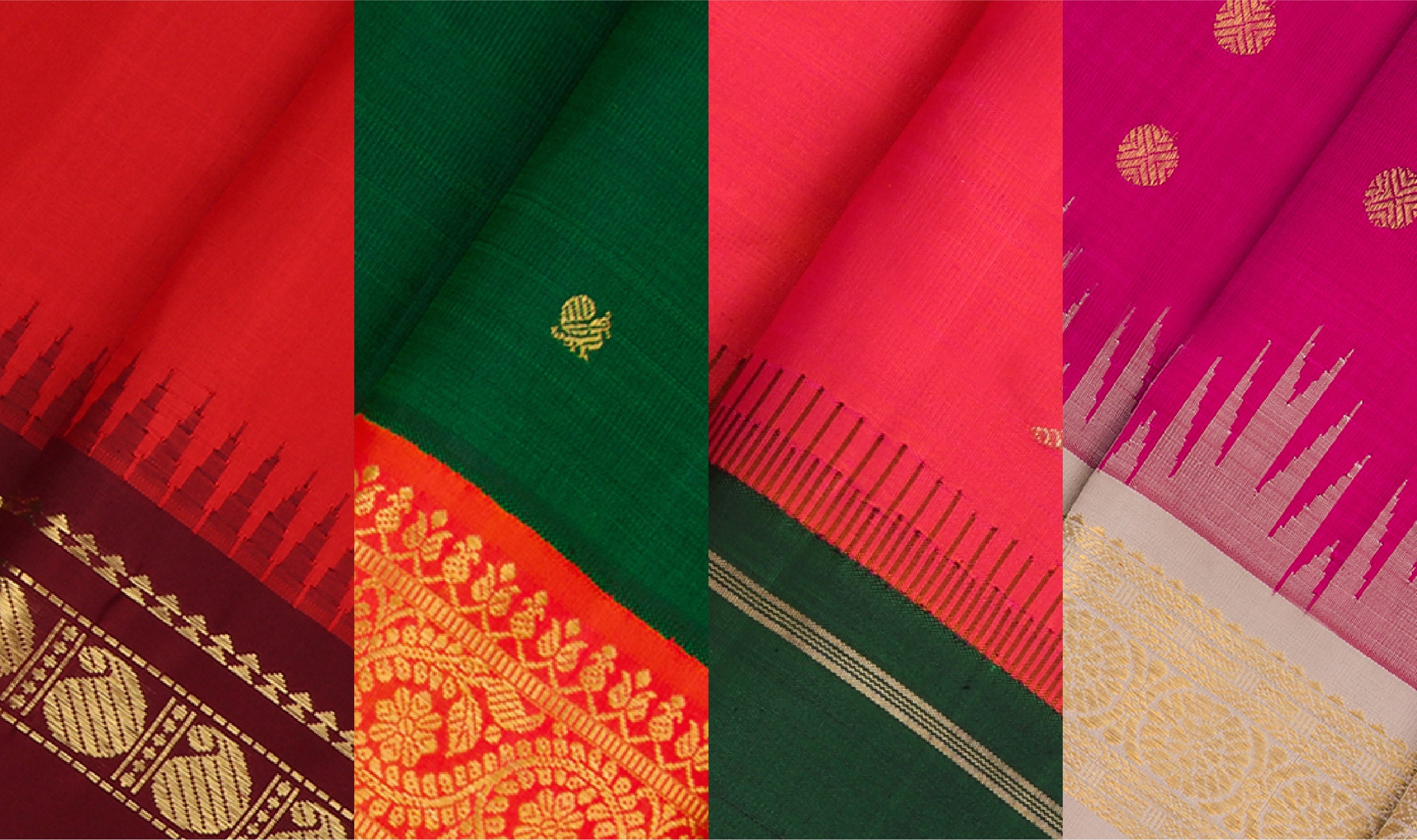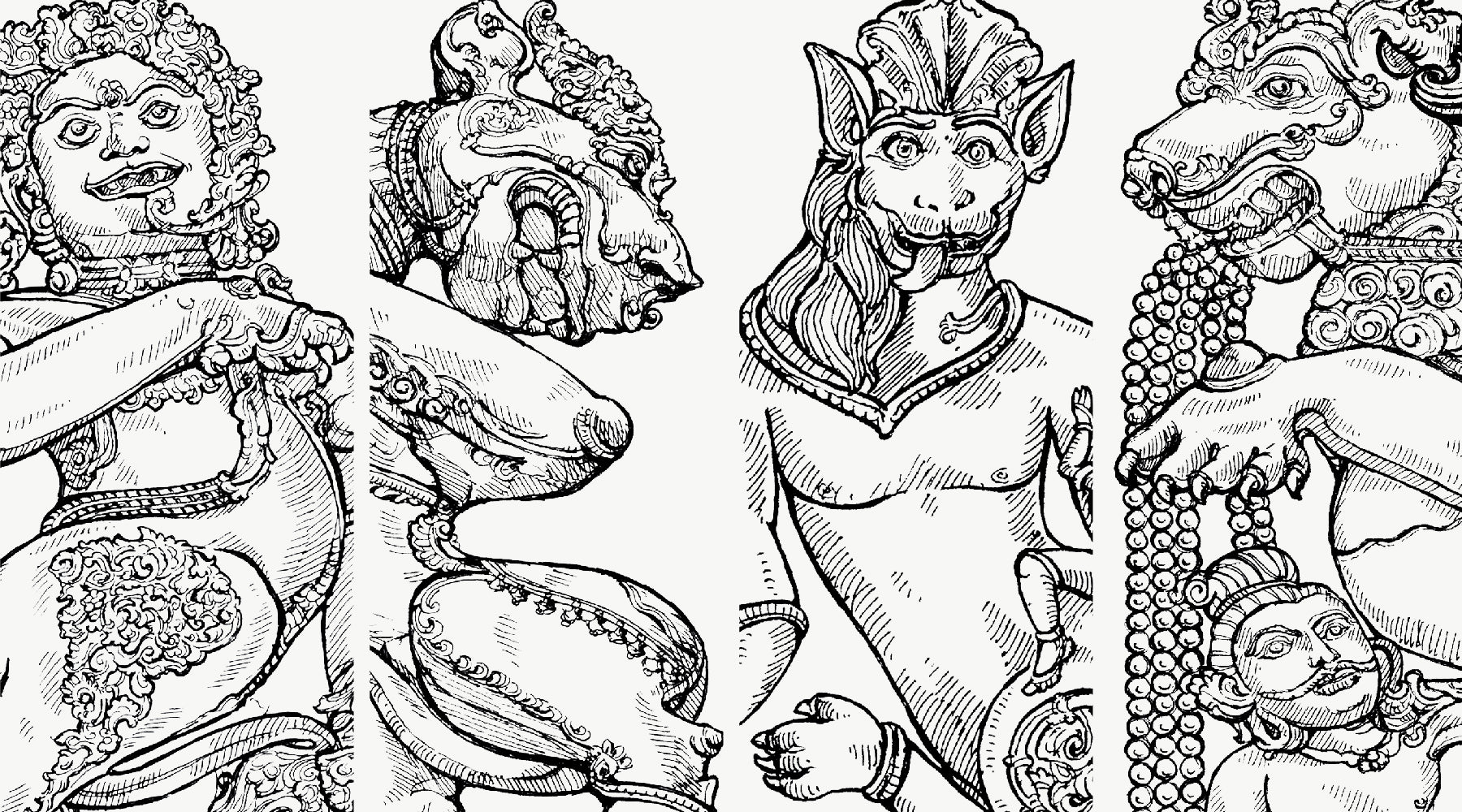Varna Sutra : Alankaranam – Weave, Adorned

The beauty of the kanjivaram’s embellishment lies not only in the forms and motifs that adorn the silk, but also in the more subtle weave details and the complex techniques used to achieve them. While motifs—ancient and varied in inspiration and depiction—play aesthetic and symbolic roles on the queen of silks, their intricacy is made possible by the skilful hand of Kanchipuram’s weavers.
Several of the kanjivaram’s symbols are recurrent across art forms–from painting and temple architecture to sculpture, Tamil literature and even dance. The kanjivaram weaver, however, interprets each motif in unique ways, to fit seamlessly into the bold layout of the drape while retaining its rich symbolism and cultural relevance. The embellishment of the kanjivaram extends beyond motifs to include delicate details and accents that require the thoughtful use of colour and weave. In doing so, the weaver employees ancient and traditional techniques that are often time consuming and laborious.
Details such as the traditional seeru and moplah patterns that adorn borders, or the treatment of the sari’s edge, known as the selvedge, weave together the various components of the drape. The laborious adai hand weaving process offers exquisite detail and striking relief to the buttas and motifs that adorn the drape. In this edition of Varna Sutra, we take a look at some of the elements of embellishment weaving that adorn the anatomy of the kanjivaram, making the craft truly special.
Weave, Adorned
While its classic motifs might draw us into a kanjivaram, it is often the tiny details that truly transform the drape. These delicate details might not stand out to the eye at first glance, but help tie together the palette of a drape and are the result of highly labour-intensive techniques.
Not only do small pieces of yarn need to be dyed for these woven accents, but the colours are also thoughtfully selected to highlight the kanjivaram. It would often be easier and less expensive to weave these details in zari, and yet effort is taken to add to the delightful colour play and traditional techniques of the craft.
Seer & Muthu Seer

In several kanjivarams from Kanakavalli’s Vault collective of exclusive, classic-format saris, you will notice hints of colour highlighting the border designs, such as the traditional fine lines or seer that are woven in contrast hues. When the lines are dotted, resembling tiny pearls, they are referred to as muthu seer. Woven in an extra warp technique, muthu seer lines are very fine - 0.1 or 0.2 centimetres in thickness - but can vary in length to suit the design language of the sari.
Moplah

Another classic pattern is known as the moplah, composed of three lines, usually woven in a contrast colour at the intersection of the borders and the body. Delicate muthu seeru often highlight this design.
Selvedge

In addition to these, the selvedge of the kanjivaram, along the border, also becomes a design detail. Featuring contrast or complementary colours that might reflect the palette of the kanjivaram in some form, the selvedge might also feature classic designs such as twill patterns, kannpetu or diamond motifs, vanki (chevron patterns inspired by the traditional armlet), muthu or dotted lines like pearls. The selvedge has a greater concentration of threads, making this area slightly thicker than the rest of the sari. It punctuates the kanjivaram's overall design, allowing the treatment of the sari’s edge to enhance its structure.
Beyond the structure and layout of the sari, the kanjivaram is known for the intricacy of its ornamentation. The extraordinary detail of the kanjivaram’s embellishment, as well as the complex techniques used by the weavers to achieve this, are fascinating.
Adai Technique

The adai technique is an ancient and traditional one used to embellish the kanjivaram. In this laborious and time-consuming process, motifs are woven entirely by hand, without the use of a jacquard machine, resulting in exquisite detail and striking relief. This highly skilled weaving technique allows for the execution of intricate patterns on a larger scale; occasionally taking the form of motifs within motifs, or beautifully complex, labyrinthine designs that come to life on the drape.
In a jacquard loom, the silk threads of the sari are connected to jacquard cards contained within a box-like machine. While weaving, this machine lifts the threads in specific patterns to create motifs and patterns on the drape. In contrast, the adai loom requires three pairs of hands working on a single sari on the loom—one weaver and two people manually operating the adai mechanism. The beauty of the adai technique is that it is not restricted by shape or size, like jacquard weaving is. As many master weavers of Kanchipuram say, adai weaving is like free-hand drawing and other art forms that cannot be contained within a frame or a box like the jacquard machine.
Butta Weaving
Traditionally on a kanjivaram, buttas are motifs that are woven using an extra weft yarn on the loom. Apart from buttas that dot the body of a kanjivaram, as if floating upon the silk, there are three other kinds of buttas, defined by their placement on the kanjivaram.
Dindu Buttas

The weavers of Kanchipuram colloquially refer to the area between the body and pallu of a kanjivaram as the 'dindu' area. ‘Dindu’ buttas are woven above the benth line, where the pallu ends and the body begins.
Beetu Buttas

While the lower edge of the sari's border is known as the selvedge, the edge closer to the body is known as 'beetu'. The motifs woven just above this, between the body and the borders, are known as ‘beetu’ buttas, lending detail and beauty to the silk.
Corner Buttas

Some kanjivarams feature dramatic corner buttas, most often consisting of striking interlocked paisleys enclosing intricate motifs and patterns. They are woven at the intersection of the body and the pallu of the sari, at a forty-five degree angle.
While saris dotted with buttas might look less complex than those with elaborate designs all over the body, the latter are likely to be woven with a jacquard while in the former layout, every single butta requires the insertion of an extra weft yarn by hand on the loom.
These weave techniques lend the kanjivaram its unique structure and ornamentation, celebrating its innate geometry and dramatic beauty. Discover the inspiration and significance behind some of the kanjivaram craft’s motifs in our Varna Sutra compendium here.
- For The Kanakavalli Journal, by Aneesha Bangera.



